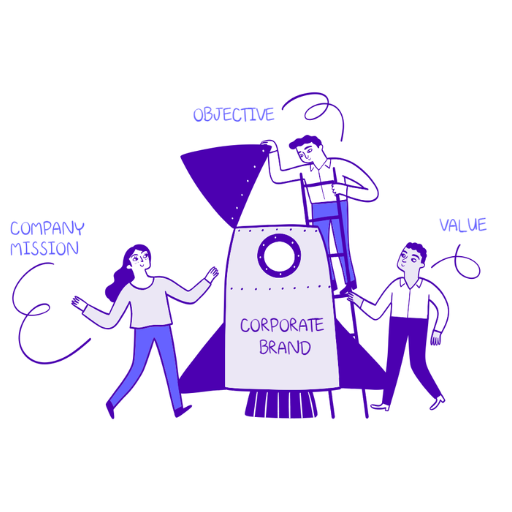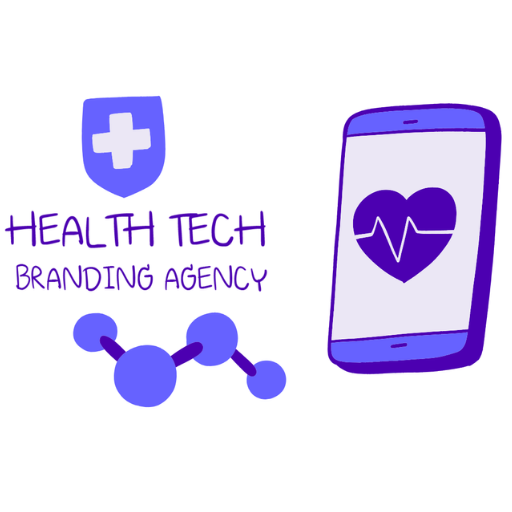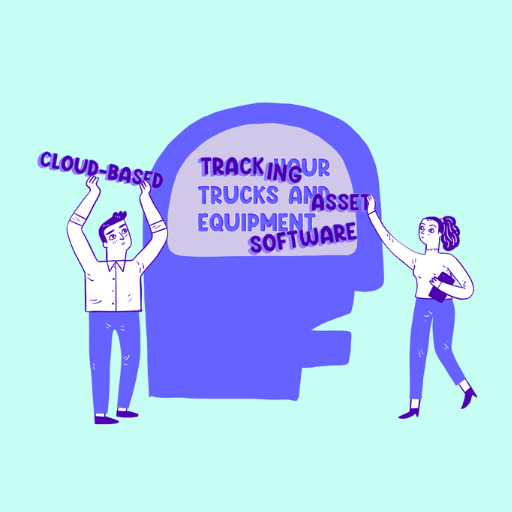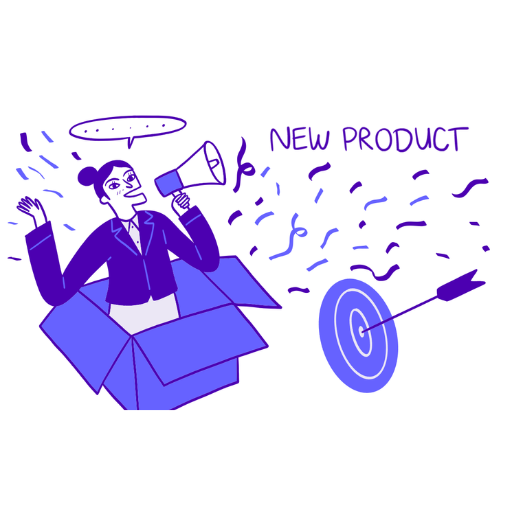Effective website branding becomes much easier when you understand the four types of marketing messaging and how to apply and integrate them to create compelling website copy that attracts and converts the right audiences, combined with UX/UI design principles that guide the website visual branding process from start to finish. This post introduces and defines the four types of website branding messaging and copy, explains how they relate to one another and shows you where they go on a modern website. In another post, we will address basic UX/UI design principles for website branding. Additionally, you can enhance your understanding by taking our brand wheel assessment to see how well-defined your brand is. Download your free e-book guide to learn more about how to refine your messaging.

Website Branding & Copywriting
Whereas marketing messages define what to say, brand tone of voice guidelines provide principles for how to communicate your brand benefits in copywriting, including practical examples of do’s and don’ts for your brand voice. Copywriting is the process of infusing your brand personality or tone of voice into the messaging you use to describe what you do and why it matters. Combining a well-thought-out messaging framework with clearly defined verbal branding or brand tone of voice guidelines ensures that whoever is writing your copy knows what to say and how to say it. One without the other will miss the mark or leave money on the table.

Brand Tone of Voice
Your brand personality informs your brand tone of voice, which is what your brand sounds like in the spoken and written word. Something as simple as how your brand greets a prospective customer can be illuminating. Does your brand say, “Hey, Hi or Howdy!” Where does your brand sit on a continuum of a standardized scale like the one below? You can change the themes to suit your brand; this is a good place to start.

Determining the personality of your brand starts with a clear understanding of who your ideal customers are, how they view the world and how they see your brand fitting into it in terms of their values and lifestyles. Focusing on creating the correct customer perception of your brand will help you avoid the classic pitfall of basing your brand’s personality on the personality of your founder or leaders. While founders’ values often and rightfully inform the company’s values and shape its culture, the personality of your brand ought to reflect the wants and values of your customers, not those who run your business.
Taking this approach is a freeing concept since the products and services you offer may not be something the leaders of your business consume, want or need. Forcing your brand’s personality to reflect the personality of your leaders or employees is an arbitrary and unnecessary limiting factor. If they happen to align, great, but don’t force it. Focus instead on creating a brand personality that connects with your customers.
The Four Types of Marketing Messaging
Robust, comprehensive and flexible messaging strategies include four types of marketing messages:
1) Brand or Company Messaging,
2) Audience Messaging,
3) Offering Messaging, and
4) Audience & Offering-Specific Messaging.
The Backstory Messaging Matrix™ illustrates the relationships among these four types of messaging.

Brand Messaging
Brand messaging, also known as company or umbrella messaging, articulates the types of problems your company solves—and the benefits you provide—for all your audiences all at once. Brand messaging is broad horizontal messaging relevant to all the types of companies and audiences you serve, regardless of their industry, functional area, or department. Imagine giving a keynote address at a customer conference and having all your customers listen to and resonate with your presentation simultaneously in the same room. Brand messaging serves this purpose. It aims to persuade prospective and existing customers to engage with you and want to learn more about what you can do to solve their problems and the benefits your offerings provide.
When all your audiences are listening to or reading the same words, you’ll naturally need to generalize and elevate what you say to a higher level so everyone can relate to your messages. Getting too specific too soon risks deeply engaging some people while causing others to tune out. For this reason, brand messaging is audience- and offering-agnostic.
In a perfect world, you would ideally communicate with each of your audiences through a discrete and dedicated channel—or better yet, one-on-one—but that’s not always possible or profitable, primarily if you serve multiple audiences with multiple offerings. And when you don’t know which segments prospective customers belong to yet, like at the top of the marketing funnel, you’ve got to connect with them at a high level with generally relevant messages so they’ll engage, share more about themselves, and allow you to talk with them in context of their specific problems and use cases. Sharing increasingly relevant messages as customers progress on their buyer’s journey through your funnel puts your brand on the shortlist of contenders for winning their business.
Website Placement: From a website branding perspective, Brand Messaging goes on your website's homepage. It provides a high-level overview of the problems you solve for all your audiences and the benefits you provide for your customers collectively.
Audience Messaging
Unlike brand messaging, which talks about generalized classes of issues that all your audiences experience and appreciate, audience messaging focuses on addressing the particular concerns and questions of a specific audience or customer segment. By definition, audience messaging speaks to the types of problems you solve for specific customer segments and the benefits you provide for those customers, but without getting into the details of how you solve them in the form of product features and advantages.
The more audiences your business and brand serves, the more challenging it becomes to develop and build an entire set of targeted audience-specific messages. It’s a time-intensive process that requires experience, skill, and collaboration with input from all your team members who have subject matter expertise and perspectives to share in uncovering, understanding, and articulating all the reasons different groups of customers buy based on your combined knowledge of their unique pain points, use cases, and jobs to be done.
Website Placement: Most websites put audience-specific messaging on their solutions pages. This type of messaging speaks to the jobs to be done for each of your audiences, their problems, and why they're important to address without getting into the details about how a specific offering addresses those issues.
Offering Messaging
Offering messaging describes your products’ general benefits and features independent of any audience. (I’m using the term product here to reference a product or service, which I’ve referred to elsewhere in this book as an offering.) A product feature names a specific product attribute or function, and groups of features are called feature sets, which we also refer to as “topics.” A single feature or feature set (topic) can enable one or more advantages that result in one or more benefits. An advantage describes what a feature does or how it works. A benefit is how a feature makes life better for a customer or consumer. This cascading effect can create increasingly more messages the further you go downstream in your messaging hierarchy.
Preparing to offer messaging in a thoughtful, thorough way sets your team up for success by equipping them with the messaging they need to create compelling product marketing content and campaigns to progress customers through the middle of your marketing funnel. Offering messaging is essential because it helps define the criteria for your customers' success at a solution category level for the general types of problems described in your brand messaging. As discussed earlier, representing the five factors required for successfully solving your customers' issues on your terms means they will use your success criteria while shopping for and evaluating potentially viable offerings that solve their problems.
Website Placement: Offering Messaging goes on your website's product suite or services page. It provides visitors with information about your offerings and the general benefits they provide to all your audiences. Unlike brand messaging, which speaks to your company's overarching benefits, offering messaging speaks about the benefits one of your specific offerings provides.
Audience & Offering-Specific Messaging
The bottom of your market funnel contains audience- and offering-specific messaging. It speaks to audience-specific offerings as the final step in delivering a marketing-qualified lead to your sales team, vetted as worthy of their valuable time and attention. This type of messaging is the most specific of all four kinds because it shows how a particular product’s features, advantages, and benefits address each audience’s pain points. Think of audience- and offering-specific messaging as vertical messaging; it’s for a specific audience within an enterprise company or industry, in contrast to the horizontal brand messaging of your high-level brand messaging.
Website Placement: Audience- and offering-specific Messaging goes on your website's Solutions page. It is often paired with screenshots highlighting features and functionality that specifically address the unique needs of a given audience or detailed product information and descriptions.
Building Out Your Messaging Framework
To streamline the website copywriting process, it’s essential that you first build out each type of messaging in a systematic, repeatable process in a comprehensive messaging framework. For B2B brands, the first step is to define the firmographics of your Ideal Customer Profiles (ICPs) and the characteristics of the individuals who make or influence buying decisions on their behalf. The larger the company and purchase, the more people are involved in the buying process. Buying committees or groups can have as many as five to eight individuals—or more—depending on the cost, complexity and potential impact of a purchase on an organization.
B2B Messaging Frameworks
In the B2B Messaging Framework example below, I’ve included a basic set of three personas, including the economic buyer, the person with the budget and authority to make the buying decision, the technical buyer, the individual who vets potential solutions from a technical performance, compatibility, and security standpoint, and the influencer, someone who influences a buying decision but doesn’t have the authority to make the decision. I also like to include the user because including their information helps to provide additional context for your overall value proposition.
Rather than giving a customer persona a clever name, like “Law Firm Larry,” I’ve found it works better to provide personas with descriptive names that are easy for your team members to remember, combined with the names of specific individuals who are good examples of each type of persona that everyone on your team or throughout your company can appreciate.
Step 1: Define your audiences.

Step 2: Build your value sequence.
The next step is to clarify and articulate the value you provide each audience with your offerings in a logical sequence. List the name of the audience in the first column and build out one row of information at a time for each audience. This information includes the name of each audience or customer persona, a first-person problem statement for that audience, and a corresponding feature or feature set, advantage, and benefit specific to that audience and problem.

Remember to be descriptive when naming your customer personas. The name of each customer persona should immediately communicate who belongs to that audience for everyone on your team, including full-time employees, freelancers, and agencies. Keep problem statements singular, focused, brief, and to the point. Remember, a product feature names a specific product attribute or function. A group of features that support one benefit is called a feature set. An advantage describes what a feature does or how it works.
A benefit is how a feature makes life better for a customer or consumer. It’s important to distinguish between functional and emotional benefits. Functional benefits speak to the quality, functionality or performance of a solution. Emotional benefits communicate the feelings customers associate with your brand and how using your products or services makes them feel.
A well-rounded messaging framework needs both functional and emotional benefits.
Combining a feature, advantage, and benefit constitutes an FAB for a specific audience and offering. Taken together, these elements form a “value sequence” that articulates a value proposition tied to a specific audience and unmet need. Like brand pillars, brand messaging has brand benefit strings that articulate value propositions that are audience and offering agnostic, whereas audience benefit strings link benefits to specific audiences. It’s also important to note that a single offering (product or service) may have multiple FABs, and one feature may have more than one advantage and benefit. That said, there should be just one benefit per row in your messaging framework to keep your messages clear and organized.
Defining FABs is a collaborative process that draws from the insights and observations of your product, marketing, sales, and client success teams -- especially your marketing and sales teams. Creating a unified FAB messaging framework strengthens and aligns working relationships among these groups. Participants leave the experience with a better rapport and appreciation for one another and a deeper understanding of what makes their company’s offerings unique and how to differentiate them from the competition. They’re better able to articulate and align the value of your offerings more clearly, consistently and effectively. They tend to succeed better by working together to solve problems and opportunities from the same side of the table instead of seeing one another as adversaries.
B2C Messaging Frameworks
The messaging inputs for B2C brands include defining your customer personas, including those who buy your products, those who influence those buyers, and those who use your products. As with B2B brands, I recommend avoiding giving B2C customers personas clever names like “Sally Soccer Mom.” From experience, it’s better to use descriptive names combined with specific examples of the names of individuals who embody each persona familiar to give your team added context.

Step 2: Articulate your value.
The process of articulating the value a brand provides for B2C customers is very similar to the B2B approach described above. It follows the same steps and sequencing without listing an ICP in the Audience column.
Unpack all the value you can
Remember to unpack all the pain points, features, advantages, and benefits for all your audiences open-endedly rather than capping them or putting a limit on them arbitrarily. You can summarize the most important benefits as part of the Message Map development process that follows for short content and campaign expressions of your value, but you’ll be glad you exhausted all of the ideas for marketing messages when it comes to creating and fulfilling a steady cadence of content as part of your content marketing strategy.
Google and other search engines favor sources of helpful information that consistently provide content that people find helpful. We're talking about link-worthy content that other sites reference in their articles and posts to boost your online credibility and authority. Supplying a steady stream of relevant content can be exhausting for the people responsible for feeding the algorithms’ insatiable appetites for new and interesting ideas. You can set them up for success by not putting the lid on quality content just because you only need a handful of benefit statements for a landing page, pop-up banner, or brochure right now.
Building a robust messaging library ensures your content creation teams can always decide what to say to your key audiences. Rather than spending valuable time trying to chase down busy executives and subject-matter experts throughout your company to interview them and generate fresh topics, your content teams can effectively and efficiently help themselves to the reservoir of meaningful and preapproved content ideas and messages you’ve already collectively created and focus on turning those ideas into compelling content pieces and campaigns rather than looking for ideas.
Frequently Asked Questions
Website branding is creating a strong brand identity and applying it consistently throughout a website to convey the brand's values, personality, and offerings to visitors. This includes elements such as brand colors, typography, imagery, and messaging, which collectively contribute to a branded website experience. Effective website branding improves brand recognition, strengthens brand loyalty, and fosters a positive user experience, ultimately driving engagement and conversions.
To brand a new website effectively, define your brand identity, including brand colors, typography, and messaging. Incorporate these elements consistently throughout the website design, ensuring they reflect the brand's personality and values. Utilize a website builder or hire a web designer who understands your brand vision and can translate it into a visually appealing and user-friendly website. Pay attention to details such as brand colors, imagery, and brand voice to create strong website branding.
To apply branding to your website, integrate your brand colors, typography, and imagery into the website design. Ensure consistency in visual elements and messaging across all pages to create a cohesive and branded website experience. Incorporate your brand voice into website copy and content to reinforce your brand identity and personality. Use design inspiration and brand guidelines to maintain brand consistency and create a visually appealing and user-friendly website that reflects your brand's values.
Ideally, branding should come before website design to ensure a cohesive and consistent brand experience. Establishing a strong brand identity, including brand colors, typography, and messaging, provides a foundation for website design that reflects your brand's personality and values. However, in some cases, website design may precede branding, especially if the website is being redesigned or branding efforts are still in progress. In such cases, it's essential to incorporate branding elements into the website design process to create a branded website that aligns with your brand identity and resonates with your target audience.
While web designers primarily focus on website design and development, many can provide branding services or collaborate with branding experts to ensure a quality brand experience. Web designers may assist in translating brand guidelines into website design elements, including brand colors, typography, imagery, and messaging. They play a crucial role in applying branding to the website to create a visually appealing and user-friendly branded website.
The duration of website branding depends on various factors, including the scope of the website design, and the availability of resources. Typically, website branding can take anywhere from a few weeks to a few months to complete. It involves defining the brand identity, creating brand guidelines, and applying branding elements to the website design. Effective communication and collaboration between the client and the web designer are essential to streamline the branding process and ensure the timely delivery of strong website branding that resonates with the target audience and reflects the brand's values and personality.
Website branding is crucial in establishing a strong visual identity for a personal brand. By integrating key branding elements such as brand colors, typography, imagery, and messaging into the website design, individuals can create a cohesive and memorable brand experience for potential customers. This contributes to brand recognition and reinforces the personal brand's identity across various touchpoints, including social media profiles and marketing materials. A well-executed website branding strategy reflects the individual's brand identity and values, enhances user experience, and supports brand strategy by attracting and engaging potential customers effectively.



.png)


%20-%20Made%20with%20PosterMyWall.jpg)
.png)
.png)
.png)

.png)





.png)








.png)
.png)
.png)

.png)



.png)




.png)







.png)
.png)

.png)
.png)


.png)
.png)


.png)
.png)

.png)
.png)
.png)
.png)